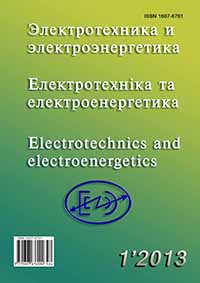OPERATIONAL FACTORS AFFECTING THE PERFORMANCE OF CONTINUOUS MONITORING SYSTEM OF TRANSFORMER EQUIPMENT INSULATION
DOI:
https://doi.org/10.15588/1607-6761-2013-1-7Keywords:
transformer, insulation continuous monitoring, condition monitoring and diagnosis, operational factorsAbstract
To ensure the required level of high voltage electrical networks reliability, special attention should be paid to the equipment technical condition monitoring and diagnosis. The periodic monitoring can only reduce the probability of device damaging. The time period between the insulation defect appearance and the device damage can be considerably less than the time interval between measurements recommended by the Testing norms and recommendations for each type of equipment. This demonstrates the lack of effectiveness of the systems of technical diagnostics and large time interval between tests. Continuous monitoring systems are free from these disadvantages. The article covers the results of the insulation continuous monitoring of current transformers and bushings at substation 330 kV «Dnipro-Donbass» Dnieper Power System. Operational factors affecting the reliability of the results are considered, and detailed analysis of errors caused by isolating transformers is given. The article describes methods and recommendations elaborated for mitigation of operational factors impact on the insulation continuous monitoring system. It should be noted that systems of continuous monitoring of transformer equipment under operating voltage are relatively new. Their implementation at the power facilities is at the initial stage. As a result, there is no reliable information on such systems operating experience. Therefore, the investigations covered by this article can be of practical value for both continuous monitoring system developers and operating personnel.References
Живодерников С. В. Разработка методики и аппаратуры регистрации частичных разрядов в электрооборудовании под рабочим напряжением : дис. канд. техн. наук: 05.14.12 / Живодерников Сергей Валентинович. – Новосибирск, 2004. – 163 c.
Нормыиспытаний электрооборудования: СОУ-НЕЕ20.302:2007. – Офіц. вид. – К. : ГРІФРЕ : М-во палива та енергетики України, 2007. – 262 с. – (Нормативний документ Мінпаливенерго України. Норми).
Спица А. Г. Системы непрерывного контроля изоляции электрооборудования подстанций / Спица А. Г. // Электрические сети и системы. – 2011. – № 5. –С. 65–73.
Сахно А. А. Источники погрешности при контролехарактеристик основной изоляции трансформаторов тока и вводов 330–750 кВ под рабочим напряжением / [Сахно А. А., Рассальский А. Н., Конограй С. П.и др.] // Сборник тезисов Трансформаторостроение- 2009. – Запорожье, 2009. – С. 67–70.
Сви П. М. Контроль изоляции оборудования высокого напряжения / Сви Павел Максович. – 2-е изд., перераб. и доп. – М. : Энергоатомиздат, 1988. – 128 с.
Шинкаренко Г. В. Контроль опорных трансформаторов тока и вводов силовых трансформаторов под рабочим напряжением в энергосистемах Украины / Шинкаренко Г. В. // Электрические станции. – 2001. –№ 5 – С. 56–62.
Соединения контактные электрические. Классификация. Общие технические требования: ГОСТ 10434-82. – [Действует с 1983-01-01]. – М. : Стандартин форм, 2007 – 15 с. – (Государственный стандартСоюзаССР).
Шинкаренко Г. В. Технические требования к системам непрерывного контроля трансформаторов тока 330–750 кВ под рабочим напряжением / Шинкаренко Г. В. // Материалы заседания электроэнергетической секции научно-технического совета НЭК «Укрэнерго» по теме: «Вимірювальні оливонаповнені трансформатори струми і напруги 110–750 кВ.
Downloads
How to Cite
Issue
Section
License
Copyright (c) 2017 A. G. Spitsa

This work is licensed under a Creative Commons Attribution 4.0 International License.
Creative Commons Licensing Notifications in the Copyright Notices
Authors who publish with this journal agree to the following terms:
Authors retain copyright and grant the journal right of first publication with the work simultaneously licensed under aCreative Commons Attribution License that allows others to share the work with an acknowledgement of the work's authorship and initial publication in this journal.
Authors are able to enter into separate, additional contractual arrangements for the non-exclusive distribution of the journal's published version of the work (e.g., post it to an institutional repository or publish it in a book), with an acknowledgement of its initial publication in this journal.
Authors are permitted and encouraged to post their work online (e.g., in institutional repositories or on their website) prior to and during the submission process, as it can lead to productive exchanges, as well as earlier and greater citation of published work.

